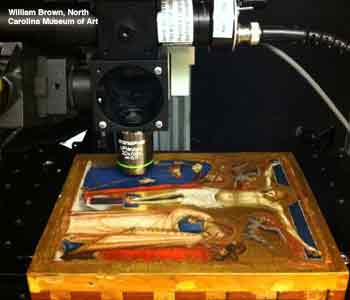
Experimental setup for pump-probe imaging. The painting is "The Crucifixion" by Italian artist Puccio Capanna, circa 1330 CE.
A near-infrared pump-probe imaging technique originally designed to detect melanoma biomarkers has a completely different use: identifying pigments in priceless artwork.
Researchers at Duke University (U.S.A.), who developed the pump-probe microscopy technique to do virtual biopsies of suspicious-looking skin lesions, are collaborating with the North Carolina Museum of Art (NCMA) to characterize pigments without defacing historical paintings and sculpture.
OSA Fellow Warren S. Warren, who leads Duke's Center for Molecular and Biomedical Imaging, says he got the idea for the project about three years ago when he saw an exhibit on scientific methods of forgery detection at London's National Gallery. He realized that the techniques on display were several decades old and wondered if the art world could benefit from recent research in biomedical imaging.
The pump-probe technique, which incorporates two near-infrared femtosecond lasers, works on substances that absorb light but do not fluoresce, according to Warren. The first, or pump, pulse excites molecules in the target substance, and the probe pulse creates more or less signal than it would have without the first pulse. Tana Villafaña, a Duke graduate student in chemistry, explains that the signals as a function of pump-probe delay provide clear signatures for different pigments.
Last year Warren and his team established that they could distinguish the types of blue pigments used in historical paintings (Opt. Lett. 37, 1310). More recently, Duke and NCMA researchers established that the blue robe of the Virgin Mary in a 14th-century Italian painting contained lapis lazuli, an expensive and rare pigment, instead of cheaper minerals such as azurite.
The collaborators have also studied an early 20th-century painting by Henri Matisse to try to figure out why its cadmium yellow pigments are turning brown and white with age. Scientists could also use the pump-probe method to determine how ancient Chinese terra cotta figurines were fired, or what colors were used on ancient statues whose painted coatings have been lost.
